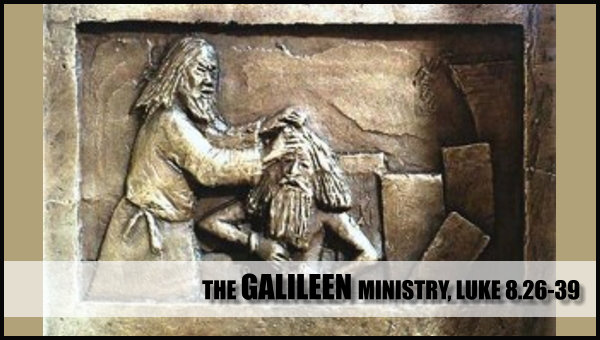By Tyson Thorne

The Galilean Ministry at Various Cities (4.14-9.50), 8.26-39
When we last left Jesus and the disciples they were traveling across the Sea of Galilee. Here we see they land at a region known as the Gerasenes (also called Gadarenes), opposite the town they had departed from. Luke notes this so the original readers would understand that this region was a gentile territory, not Jewish. The “town” Luke references without naming is likely Sennabris, located near the coast and home to herdsmen of many kinds, including pigs.
Here they encounter a man that is one of the creepiest people in Scripture. Matthew, Mark and Luke all give the account of the demoniac of Gerasene (John doesn’t have any accounts of Jesus’ encounters with the demonic realm). It is such a compelling story it has become one of the most studies passages among demonologists of most every religion. Doctor and respected author Kurt Koch (Dr. Kurt Koch, Occult Bondage and Deliverance, © Kregel Publications 1970) relates eight symptoms of demon possession as discovered from the passages on this particular case:
- The demoniac had an unclean spirit. In other words, he was indwelt by another being (8.27; see also Mark 5.2, Matthew 8.28).
- The possessed man exhibited unusual powers of physical strength. No one could bind him any more (8.29; see also Mark 5.3, Matthew 8.28).
- The third characteristic was the paroxysms (the fits of rage). He had wrenched chains apart and broken his fetters in pieces (8.29; see also Mark 5.4, Matthew 8.28).
- The fourth sign is one of disintegration, the splitting of the personality. The demoniac runs to Jesus for help, yet cries out in fear (8.28; see also Mark 5.6-.7, Matthew 8.28-.29).
- The fifth sign is that of resistance, an opposition to the Christian faith and spiritual things. He tells Jesus to leave him alone. One meets this resistance to spiritual help quite often in counseling subjected people (8.28; see also Mark 5.7).
- The sixth symptom is hyperesthesia, an excessive sensibility. The Gadarene had clairvoyant powers. He knew immediately who Jesus was (8.28; see also Mark 5.7, Matthew 8.29).
- The seventh sign is seen in the variation or alteration of voice. A “legion” of demons spoke out of him (8.30-.31; see also Mark 5.9).
- The eighth characteristic is occult transference. The demons left the man and entered the swine (8.32-.33; see also Mark 5.13, Matthew 8.30-.32).
I’ve often wondered how it is that Jesus and the disciples can immediately exorcise demons, and modern exorcists need to employ lengthy rituals. This passage indicates that perhaps not all exorcisms in the New Testament are instant. The Greek language here, most often translated “Jesus commanded”, probably reads more accurately “Jesus began commanding”. We won’t get into all the grammar involved, but it does indicate that Jesus commanded and kept commanding the demons to leave. This isn’t the only passage that indicates a prolonged exorcism, however. Jesus tells to the disciples on one occasion that “this kind [of demon] only comes out through prayer” (Mark 9.29). This would indicate that there are different kinds of demons and different methods for casting them out, and that unless there is no other alternative most Christians should leave exorcism to those practiced in the skill.
It may also be that the continued commanding wasn’t a result of the demons’ disobedience to Jesus, but that he had to command each one that had possessed the man. They admitted they were “legion”, a military term denoting “thousands”. If this is the case, it does not appear that the demons left one at a time. Only after the final release did they depart into the pigs, as Jesus permitted. Regardless of how it occurred, the point is that Jesus has authority over the spirit world. Next time, we see Jesus’ authority over sickness and death.
|
|